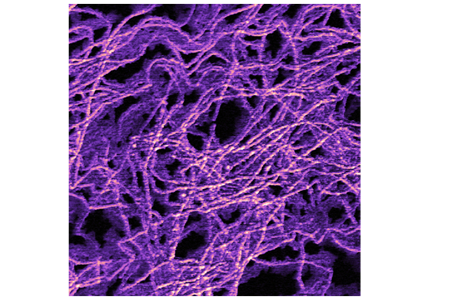Ferroelectric materials have the potential to revolutionize high-density data storage. However, exploiting their potential depends on increasing our knowledge of nanoscale ferroelectric domains, and creating new ways to design and manipulate their properties.
Piezoresponse force microscopy (PFM) is the only technique that can provide nanoelectromechanical information about ferroelectric materials. Now, a team of researchers from Korea has used the method to create and manipulate complex nanoscale ferroelectric domains.

Ferroelectric materials display spontaneous electric polarization that can switch between two or more stable states by applying an electric field. As a result, they offer a wide range of properties that are exploited in applications, including capacitors, sensors, information storage, laser components, signal processing, and overload protection devices.1,2
Creating and controlling ferroelectric domains
Ferroelectric materials often consist of spatially confined domains, with constant electrical dipole moments within each domain. The energy required to switch the dipole moment in each domain can vary, leading to hysteresis as the electric field changes.3
Manipulating ferroelectric domains can provide materials with new, desirable properties. Ferroelectric materials with nanoscale domains have been highlighted in recent years for their potential to significantly increase the amount of data we can store in our devices.2,3
As a result, exotic domain states in ferroelectrics have been a rapidly expanding area of research over the last decade. For example, scientists have created ferroelectric textures like skyrmions and vortices in various nanostructures.4,5
However, dipoles in ferromagnetic materials can also be arranged in complex patterns without the need for the spatial confinement provided by nanostructures. These complex patterns could facilitate the design of materials with efficient, high-density information storage.4,5
Recent research has identified the presence of complex ferroelectric textures, including bubble structures and vortex arrays. However, creating, observing and manipulating single vortex-antivortex pairs on otherwise flat, trivial surfaces remains a tantalizing challenge that could unlock precise control of topological textures in ferroelectrics.6
Imaging ferroelectric domains with piezoresponse force microscopy (PFM)
PFM is a form of atomic force microscopy (AFM) that detects local piezoelectric deformation. It is the only way to observe electromechanical properties with nanoscale resolution.7
The technique uses an AFM probe in contact mode with an alternating bias to the tip. The probe scans the surface of the sample, applying a localized electric field. The electric field causes minute surface displacement that can be detected with picometer precision. The amplitude of the PFM signal provides information about the magnitude of the local electromechanical coupling, while the phase of the signal gives local polarization orientation.7
When the polarization is aligned with the electric field, the domain expands, and when the polarization is anti-aligned, the domain contracts (for positive electrostrictive coefficient). These expansions and contractions can be monitored using vertical PFM. 7
If the polarization is not parallel or antiparallel tothe electric field, there is shear displacement, and vertical PFM is insufficient to fully characterize the polarization state of the sample. To overcome this problem, lateral PFM measurements detect in-plane displacements using the torsional movement of the cantilever.7,8
However, lateral PFM signals can be affected by sample orientation, so multiple PFM images at different orientations (known as angle-resolved PFM) can be required to obtain a full characterization of complex domains. The images are then combined using mathematical manipulation to construct images.8
Monitoring these expansions, contractions, and sheer displacements using PFM creates images of ferroelectric domains across the surface of the sample and provides information about the distribution of domains and effects of surface topography on ferroelectric properties.7,8
Manipulating single vortex-antivortex pairs with PFM
In a recent publication in npj Quantum Materials, researchers from the Korea Advanced Institute of Science and Technology (KAIST) described how they created a single vortex-antivortex pair in an otherwise flat ferroelectric material using PFM.6
All of their PFM measurements were achieved using a Bruker MultiMode V (now MultiMode 8) equipped with a Nanoscope V controller and Pt-coated Si tips.6,9
The team synthesized a ferroelectric BiFeO3 (BFO) thin film with a flat surface. They characterized the BFO film using PFM and found that it had alternating polarization domains resembling stripes, a relatively trivial ferroelectric topology.6
The researchers found that when they applied a negative electric pulse to the AFM tip, they were able to induce local polarization switching and create a vortex-antivortex pair in the BFO film. Then, using tip-induced electric fields, they were able to separate the vortex-antivortex pair and precisely control the distance between them.6
They studied the texture of the pair using angle-resolved PFM to create a full map of the piezoresponse vectors, demonstrating that they were successfully able to create and control topological defects in their flat ferroelectric material.6
PFM opens the door for precise ferroelectric component design
We are just beginning to discover the potential of ferroelectric materials with exotic nanoscale properties. In the future, they will undoubtedly play a central role in electronics.
PFM is currently the only way to study nanoelectromechanical properties, so it is destined to play a critical role in understanding, manipulating, and observing new ferroelectric materials and their applications.
References and further reading
- ‘Springer Handbook of Electronic and Photonic Materials’ — Kasap S, Capper P, Springer, 2017.
- ‘World record data density for ferroelectric recording’ https://phys.org/news/2010-08-world-density-ferroelectric.html
- ‘Ferroelectric Materials and Their Applications’ — Xu Y, Science, 2013.
- ‘Topological Structures in Ferroic Materials‘ — Seidel J, Springer, 2016.
- ‘Exotic Domain States in Ferroelectrics: Searching for Vortices and Skyrmions’ — Gregg JM, Ferroelectrics, 2012.
- ‘Artificial creation and separation of a single vortex-antivortex pair in a ferroelectric flatland’ — Kim J, You M, Kim KE, Chu K, Yang CH, npj Quantum Materials, 2019.
- ‘Piezoresponse force microscopy and nanoferroic phenomena’ — Gruverman A, Alexe M, Meier D, Nature Communications, 2019.
- ‘High-resolution angle-resolved lateral piezoresponse force microscopy: Visualization of in-plane piezoresponse vectors’ — Chu K, Yang CH, Review of Scientific Instruments, 2018.
- ‘MultiMode 8-HR’ https://www.bruker.com/products/surface-and-dimensional-analysis/atomic-force-microscopes/multimode-8-hr/overview.html